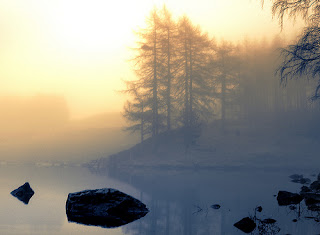The Lake District, also known as The Lakes or Lakeland, is a mountainous region in North West England. A popular holiday destination, it is famous for its lakes and its mountains (or fells), and its associations with the early 19th century poetry and writings of William Wordsworth and the Lake Poets.
The central, and most visited, part of the area is called the Lake District National Park which was designated as a National Park in 1951. It is the largest of thirteen National Parks in England and Wales, and second largest in the UK (after the Cairngorms). It lies entirely within the modern county of Cumbria, shared historically by the counties of Cumberland, Westmorland and Lancashire. All the land in England higher than three thousand feet above sea level lies within the National Park, including Scafell Pike, the highest mountain in England. It also contains the deepest and longest lakes in England.
The Lake District is approximately 34 miles (55 km) across. Its features are a result of periods of glaciation, the most recent of which ended some 10,000 years ago. These include the ice-carved wide U-shaped valleys, many of which are now filled with the lakes that give the park its name. The upper regions contain a number of glacial cirques, which are typically filled with tarns. The higher fells are rocky, with lower fells being open moorland, notable for its wide bracken and heather coverage. Below the tree line, native oak woodlands sit alongside nineteenth century pine plantations. Much of the land is often boggy, due to the high rainfall. The Lake District is one of the most highly populated national parks. Its total area is near 885 square miles (2,292 km2). The mountains of the Lake District are frequently named on maps as the "Cumbrian Mountains", although this designation is widely forgotten and the area simply referred to as "the Lake District".
The north-western area stands between the valleys of Borrowdale and Buttermere, with Honister Pass joining the two dales. This area comprises the Newlands Fells (Dale Head, Robinson, Catbells) and the ridge joining them. To the north stand Grasmoor, Grisedale Pike and the hills around the valley of Coledale, and in the far north-west is Thornthwaite Forest and Lord's Seat. The fells in this area are rounded Skiddaw slate, with few tarns and relatively few rock faces.
The western part is the area between Buttermere and Wasdale, with Sty Head forming the apex of a large triangle. Ennerdale bisects the area, which consists of the High Stile ridge north of Ennerdale, the Loweswater Fells in the far north west, the Pillar group in the south west, and Great Gable (2,949 feet / 899 metres) near Sty Head. Other tops include Seatallan, Haystacks and Kirk Fell. This area is craggy and steep, with the impressive pinnacle of Pillar Rock its showpiece. Wastwater, located in this part, is England's deepest lake. Rising up around the Western Valley of Wasdale is Scafell Pike, England's highest mountain.
The eastern area consists of a long north-to-south ridge—the Helvellyn range, running from Clough Head to Seat Sandal with the 3,118-foot (950 m) Helvellyn at its highest point. The western slopes of these summits tend to be grassy, with rocky corries and crags on the eastern side. The Fairfield group lies to the south of the range, and forms a similar pattern with towering rock faces and hidden valleys spilling into the Patterdale valley. It culminates in the height of Red Screes overlooking the Kirkstone Pass.
The far-eastern fells lie on the other side of Patterdale and are characterised by steep sides leading up to a huge moorland plateau, again on a north–south axis. High Street is the highest point on the ridge, overlooking the hidden valley of Mardale and Haweswater. In the south of this region are the fells overlooking Kentmere, and to the east is Shap Fell, a huge area that is more akin to the Pennines than the Lakes, consisting of high flat moorland.
The mid-western fells form a triangular shape, with the corners at the Irish Sea, Borrowdale and Langdale. They comprise the Wastwater Screes overlooking Wasdale, the Glaramara ridge overlooking Borrowdale, the three tops of Crinkle Crags, Bowfell and Esk Pike overlooking Langdale and Scafell Pike in the centre, at 3,209 feet (978 m) the highest ground in England. Scafell one mile (1.6 km) to the south-west is slightly lower but has a 700-foot (210 m) rock face on its north face, Scafell Crag. The valley of Eskdale penetrates this upland wilderness. These fells are the most rugged and craggy of all, and consequently going is slower amongst the tumbled granite.
The south-western fells have as their northern boundary the Hardknott and Wrynose Passes. These are particularly narrow and steep, with tight hairpin bends. The Furness Fells (invariably referred to as the Coniston Fells by walkers) stand between Coniston and the Duddon Valley, which runs NE-SW through the centre of the area. On the other side of the Duddon is Harter Fell and the long ridge leading over Whitfell to Black Combe and the sea. The south of this region consists of lower forests and knolls, with Kirkby Moor on the southern boundary. The south-western Lake District ends near the Furness peninsulas, which leads to Cumbria's second largest settlement (Barrow-in-Furness). The Castlehead field centre is in this area.
The south-eastern area is the territory between Coniston Water and Windermere and east of Windermere. There are no high summits in this group; it is mainly low hills, knolls and bumpy terrain such as Gummer's How, Whitbarrow and Top o' Selside. The wide expanse of Grizedale Forest stands between the two lakes. Kendal and Morecambe Bay mark the edge.
#taken from Lake District






